Scottish Family Crest With the Cross of St Andrew & St George
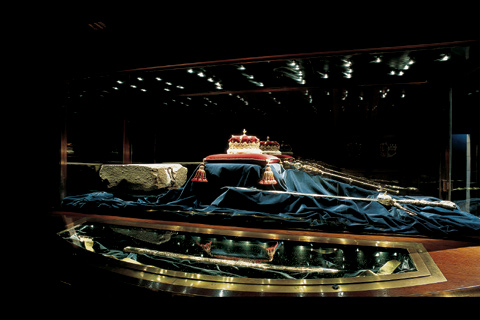
Honours of Scotland
The Scottish Crown Jewels, known equally the Honours of Scotland, are the oldest regalia in the British Isles. They comprise a crown, a sword and a sceptre, all of which date from the 15th and 16th centuries.
It is believed that the S ilver S c ep tre was a gift from Pope Alexander VI in 1494 to King James IV . The S word of Due south tate is another Pap el gi ft, this ti me from Julius Two, who commissioned Michaelangelo to paint the Sistine C hapel.
The Crown of Scotland was fabricated for King James V in 154 0. I t was refashioned from a da m aged and lighter c rown by an Edinburgh goldsmith. The Honours we re kickoff used as regalia in the Coronatio n o f Mary, Queen of Scots in 154 three . She was a mere nine months one-time.
Afterward the union of Scotland and England in 17 07 t he new United K i ngdom Parliament sabbatum in London , so the Honours were locked away in Edinburgh Castle. Later a campaign by Sir Wal ter Scott , t h ey were re- discovered in 1818 still in thei r protective line north covers .
Together with the Rock of Destiny, these symbols of Scottish nationhood are on permanent public brandish in the Crown Room at Edinburgh Castle.
Stone of Destiny
Wrapped in legend this aboriginal symbol of the Scottish monarchs has played an important office in the inauguration of Scottish Kings for centuries. Experts believe that the stone was first used at the Coronation of Kenneth MacAlpin, the Ninth Century.
In 1296 King Edward I of England captured the rock and had it taken to Westminster Abbey. It was placed underneath the wooden chair on which all subsequent English language monarchs were crowned,
On Christmas Day, 1950 a group of Scottish students liberated the stone and returned information technology to Scotland. Subsequently a nationwide search, the stone was found on the altar of Arbroath Abbey and returned to London. It was last used in the Coronation of Queen Elizabeth in 1953.
The British Government returned the Stone of Destiny to Scotland in 1996 where it is on display.
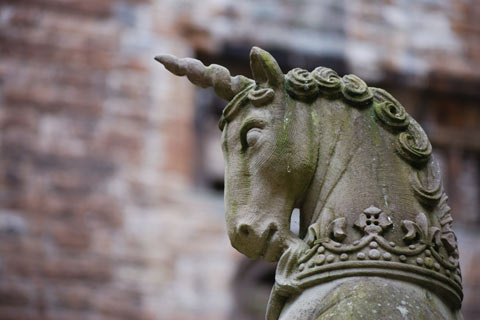
Unicorns
Scotland's national animal is the Unicorn. According to Celtic sociology, the unicorn represented purity and innocence together with supremacy and ability.
The mythical fauna appeared on the Scottish Royal Coat of Arms in the 12th Century. In 1603 Rex James VI of Scotland became King James I of England and Republic of ireland. To demonstrate that the countries were united he replaced one of the unicorns with a king of beasts, the national animal of England. Every bit the unicorn is the strongest of all animals, information technology appeared on the crest in a chain to symbolise the power of the King.
The Kilt
The original kilt
The feileadh mor was a longer untailored garment, effectually v metres in length, which was gathered a nd t hen belted at the waist to provide comprehend for both the upper and lower torso. From the waist down, the feileadh mor res embled a modern kilt while the remaining fabric above the waist was draped over the shoulder and pinned there. This upper portion cou ld b east arranged in a diversity of ways around the shoulders according to the demands of weather, temperature or freedom of m ovement required. At the end of day, the belt could be unbuckled to transform the feileadh mor into a warm roofing for the night. The Gae fifty ic plaid actu marry means ''blanket''.
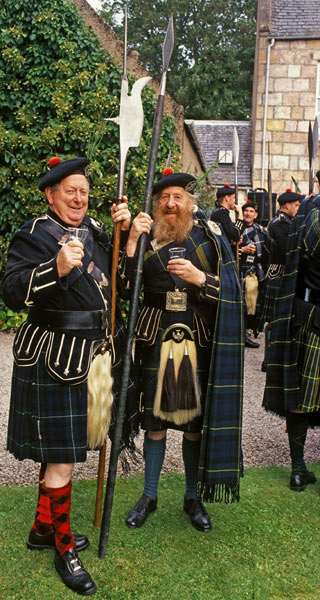
The kilt evolves
The feileadh mor was simplified by disposing of its top half, l eaving the belt and the brim below. The resulting cosmos became known as the feileadh beg, or ''trivial kilt''. This was reputedly at th e bidding of an Englishman running an ironworks at Invergarry who felt his kilted employees needed a greater liberty of motility to do their work. Whatever the impetus for alter was, the kilt at present became a tailored garment with sewn-in pleats, making it nea t er and far mo re like shooting fish in a barrel to put on and habiliment. The upper half of the big kilt evolved into the separate plaid (or sash) whi ch is now worn at more formal events.
Proscription and survival
Post-obit the Jacobite defeat at Culloden in 1746, the kilt and oth er aspec ts of Hig hland dress were outlawed and its continued survival during these years was largely due to its adoption by Highland regiments serving with the British army.
Highland regiments even so habiliment the kilt on regular footing (although no longer into bat tle) but it is non an everyday commodity of wearing apparel in Scotland. Visitors are more probable to see kilt-wearers at formal cel ebrations such every bit weddings and at Highland Games or similar gatherings. And although the kilt is typically regarded as existence Highland dre ss, m ore kilts are now worn in the Lowland cities than in the Highlands.
The kilt today
Modern kilts take up to eight chiliad etres of material which is thickly pleated at the back and sides, with the pleats stitched together simply at the waistband. Mode des ign ers h ave likewise t ried to update the kilt and make it entreatment to a wider audition past using non-tartan designs such equally camou flage and cloth such every bit leather or tweed .
The Thistle
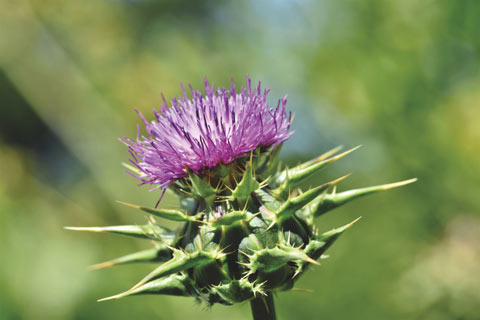
The thistle fable
Only why is it that such a proud people as the Scots shoul d c hoose a humble weed as its national symbol? In truth, no-one knows. There is a legend which relates how a sleeping political party of Scots warriors were about set upon by an invading band of Vikin gs and were only saved when one of the attackers trod on a wild t his tle w ith his blank feet. His cries ra ised the alarm and the roused Scots duly defeated the Danes. In gratitude, the institute became known as the Guardian Thistle and was adopted as the symbol of Scotland.
Sadly, there is no historical evidence to support th e t ale , and in fact, there' s fifty-fifty confu sion as to the type of thistle that nosotros see represented everywhere. There are many species of thistle and the spear thistle, stemless thistle, cotton thi stle, Our Lady 's thistle, musk thistle and melancholy thistle hav e a ll be en suggested as possible candi dates.
The thistle equally a symbol
Any its origins, the thistle has been an important Scottish symbol for more than 500 years. Perhaps its first recognis able use was on silvery coins issued in 1470 during the reign of Jam es Two I and from the early on 16th centur y, information technology was incorporated into the Royal Arms of Scotland. Scotland 's premier Lodge of Chivalry is The Most Ancient and Noble Order of the Thistle . It was established in 1687 , and i ts members article of clothing a collar concatenation whose l ink s are made of gilt thistles. The Knights and Ladies of the Thistle also wear a chest star which bears the thistle emblem . The motto which is regularly associated with the Thistle is , Nemo Me Impune Laces sit - ''no-one provokes me with impunity''.
The Saltire
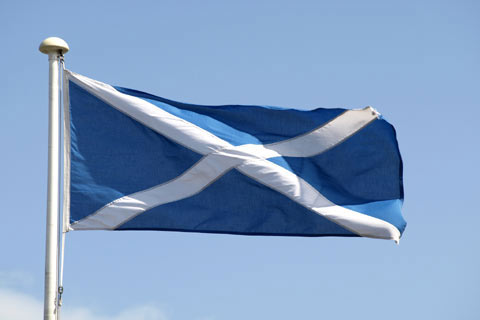
This flag is part of Scotland's special identity. The Scottish flag or `saltire' is derived from the cross of St Andrew, Scotland'south patron saint. Its adoption is said to appointment from a battle, some say in 756 between a combined force of Picts and Scots against invading Northumbrians under their leader Athelstane. King Angus I of Scots prayed to St Andrew and a vision of the cross of St Andrew was seen, white against a blue sky. This helped the Scots to victory. You will encounter the flag flight in enough of locations throughout the country, as Scotland's own symbol, notably at Athelstaneford, near Haddington, E Lothian, site of the ancient battle.
The cantankerous is too function of the Union Flag, a symbol of the United kingdom of great britain and northern ireland.
The Lion Rampant flag was chosen by William I of Scotland for his standard. It shows the scarlet lion continuing on its hind legs surrounded by a border of fleurs-de-lis.
Source: https://www.scottishtours.co.uk/aboutscotland/ions-and-symbols-of-scotland/